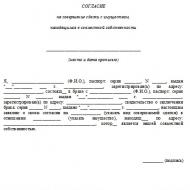
What is a letter of credit? What is a letter of credit in simple words: how to issue it, calculation scheme and types of letters of credit. Revocable and irrevocable
Letter of Credit– an obligation of the bank, provided at the request of the client, to pay a third party when the recipient of the payment provides documents to the bank executing the letter of credit, provided for by the conditions letter of credit The client company on whose behalf the letter of credit is opened is usually called the payer under the letter of credit, or the applicant. The recipient of payment under a letter of credit is called the beneficiary. In this case, the bank’s obligation is independent of the obligations of the parties under the main agreement, which provides for a letter of credit form of payment between the supplier and the buyer. Thus, the bank acts as a guarantor between them.
Suppose a seller and buyer enter into a deal. They are dealing with each other for the first time and are not ready to work on an advance payment or pre-delivery basis. Then the buyer applies to the bank with an application to open a letter of credit for the amount due to the seller for the shipped goods. Evidence of the fulfillment of the contract on the part of the seller can be, for example, documents on the shipment of goods. As soon as the subject of the transaction is transferred to the buyer or an independent carrier, the seller sends the required documents to the executing bank in accordance with the terms of the letter of credit. The buyer's bank makes payment under the letter of credit in accordance with the instructions received from the nominated bank. Letter of credit transactions involve a number of bank commissions, paid in accordance with the terms of the letter of credit. Typically, the fee for opening a letter of credit is paid by the buyer.
Letters of credit allow you to guarantee payment to the supplier, while, as a rule, funds are not diverted from circulation.
The letter of credit form of payment is used both in foreign and domestic trade. Letters of credit used in international payments, are subject to the Uniform Customs and Practice for Documentary Credits, International Chamber of Commerce Publication No. 600, as amended 2007 (hereinafter referred to as UCP 600).
Letters of credit used for domestic Russian settlements are subject to the Regulation of the Central Bank of the Russian Federation No. 2-P dated October 3, 2002, and from June 9, 2012 - “Regulation on the rules for making transfers Money» No. 383-P dated June 19, 2012.
Domestic letters of credit can be classified into the following groups:
Revocable and irrevocable;
Confirmed and unconfirmed;
Covered (escrowed) and guaranteed.
All letters of credit, in accordance with UOP 600, are currently irrevocable. Coverage in international letters of credit is rarely used - only in the case of confirmation of a letter of credit opened by the issuing bank, for which the confirming bank does not set limits.
A confirmed letter of credit is one under which another bank, in addition to the obligation of the issuing bank, undertakes an additional obligation to make payment in favor of the beneficiary upon presentation latest documents, fully complying with the terms of the letter of credit, regardless of whether the funds will be transferred to him or not. If there is no obligation from another bank, then the letter of credit is unconfirmed.
Covered (deposited) - a letter of credit, the amount of which is transferred in full to the cover account in the beneficiary's bank at the expense of the payer or at the expense of the loan provided.
Uncovered (guaranteed) - a letter of credit, upon opening of which the issuing bank does not transfer funds to the letter of credit account in the beneficiary's bank, but gives it the right to write off the required amount within the amount of the letter of credit from its correspondent account or agrees on payment in another way. Usually large banks are open with each other credit lines, therefore in developed countries virtually all letters of credit are classified as uncovered.
In addition, letters of credit are of the following types.
A letter of credit with a red clause is a letter of credit under which the supplier receives a certain amount in the form of an advance before shipping or other documents evidencing the fulfillment of obligations are provided. In this case, the payment is made against the presentation by the beneficiary of the documents provided for by the terms of the letter of credit. The name comes from the times when such an important clause was highlighted in red ink in the document. Of course, nowadays almost all letters of credit are issued and confirmed electronically.
Revolving - a letter of credit opened for a portion of the payment amount and automatically renewed as payments are made for the next batch of goods. Opens with regular deliveries and payments.
Transferable (transferable) - a letter of credit that provides for the possibility of transferring part of the letter of credit in favor of other beneficiaries.
A standby letter of credit, the so-called stand-by, is a form of bank guarantee in the form of a letter of credit, used where banks are prohibited from issuing guarantees (for example, in the USA). Payment to the exporter is made if the importer refuses to make payment under the contract and submits documents that meet the conditions to the executing bank standby letter of credit. That is, such a letter of credit serves to ensure greater security for the supplier.
According to the method of execution, letters of credit are divided into letters of credit with payment upon presentation of documents (by payment at sight), with deferred payment and with acceptance of drafts.
A letter of credit is a conditional obligation of the bank to make, at the request of the client, payments to individuals and organizations at his expense within the amount and conditions that were agreed upon in advance.
A letter of credit is a transaction that is carried out between one or more financial institutions in non-cash form. The basis for the operation is a specialized application, which is drawn up in the prescribed form and submitted by the buyer in favor of the supplier of the service or product. The parties involved can be only individuals, only legal entities, or both individuals and legal entities.
What is a letter of credit in simple language? This is a very convenient form of interaction, which, however, is rarely used due to its complexity. A letter of credit is a form of payment that guarantees payment for the supplier and fulfillment of the terms of the contract for the buyer. After delivery of a product or provision of a service, the bank pays the seller its cost. The buyer, in turn, returns the funds to the bank, including interest.
The letter of credit form of payment can be used not only in domestic trade, but also in foreign trade. When applied in international trade, the procedure is governed by the Uniform Customs and Practice for Documentary Credits, International Chamber of Commerce Publication No. 600, as amended 2007.
Very often, a letter of credit is compared with a bank guarantee and factoring, however, these concepts are similar only at first glance. Learn more about the letter of credit in the video below.
What is a letter of credit: features of banking services
The use of this form of payment began to develop in Soviet times. OJSC Bashkir Soda Company, which produces caustic soda and is on the verge of bankruptcy, switched to a letter of credit form of interaction with clients in order to still continue its activities.
Funds were credited only after the company provided the bank with documents confirming the fulfillment of the terms of the contract, which were carefully checked. In this example, it can be seen that the letter of credit provided certainty to both parties.
Calculation scheme
Participants in settlements:
- a bank client who uses the service of opening a letter of credit;
- the issuing bank or organization that undertakes the opening obligations;
- executing bank - the organization making payments;
- physical or entity, in whose favor the letter of credit was opened.

The letter of credit scheme is quite simple. It includes several mandatory steps:
- At the initial stage, the buyer and seller enter into an agreement for the supply of products or provision of services.
- The buyer contacts the bank, where he fills out an application to open a letter of credit. The application is drawn up in the prescribed form.
- The issuing bank notifies the bank that services the seller about the opening in his name.
- The executing bank, in turn, notifies the seller.
- The seller delivers goods or provides services.
- The seller notifies the executing bank that its obligations to the buyer have been fulfilled.
- The executing bank makes payment in favor of the seller in the agreed amount.
- The executing bank notifies the issuing bank of the payment to the seller.
- The issuing bank, in turn, compensates the payment to the executing bank.
- Payment documents are transferred to the buyer.
- The buyer studies the documentation and signs an agreement to pay funds to the issuing bank.
- Withdrawal of funds from the buyer's account and crediting them to the bank.
The service is provided by the issuing bank on the basis of an application, drawing up an agreement on form 0401063. This document guarantees the supplier that the product or service will be paid for within the agreed time frame. The buyer's funds may not be provided at the end of the algorithm; they may be deposited in advance.
Agreement: drafting, conditions, form
A well-drafted contract includes the following points:
- names of banks, cooperating organizations or full names and passport details of individuals;
- the amount of the letter of credit payment for the services or products provided;
- letter of credit form of payment - non-cash or the use of cash is not allowed;
- methods of notifying parties to the agreement;
- the period during which the contract is valid. During this period, the terms of the agreement between the buyer and the seller must be fulfilled, payment must be made, and all documents must be submitted;
- liability of the parties that will result from failure to fulfill obligations in accordance with this legislation.

The standard list of conditions indicated above may be supplemented with additions regarding the procedure for carrying out calculations. For example, not a full payment, but a share payment may be used. A letter of credit can be issued for payment to one individual or organization. However, the person through whose funds the payment will be made can be changed if this is specified in the contract - the possibility of acceptance.
Types of Letter of Credit
When using this form of mutual settlements, it is very important point is the selection of a suitable type of letter of credit. Any variety is opened by financial institutions, and the type is indicated in the agreement. The types are prescribed in the Regulations of the Central Bank of the Russian Federation:
- According to the type of settlements of financial organizations - covered and uncovered. In the first case, the issuing bank carries out cash payments at the expense of his client’s funds in favor of the executor’s bank for the entire duration of the agreement. In the second, transfer of funds from one financial organization in favor of another is not fulfilled. At the same time, the executing bank has the opportunity to write off funds within the agreed amount, after which this is compensated by the issuing bank.
- If possible, recall - revocable and irrevocable. In the first case, the form of interaction can be changed or rejected without prior agreement with the opposite party, in the second - only with agreement.
- Confirmed or unconfirmed. In the first case, payments are possible without agreement with the issuing bank and receipt of funds from it.
Legal regulation
The letter of credit agreement is clearly regulated by this legislation Russian Federation and is compiled according to the rules prescribed in regulatory documents Central Bank Russian Federation in the event that the agreement is drawn up between domestic organizations or residents of the Russian Federation.
The following must be taken into account: regulations:
- Articles of the Civil Code of the Russian Federation from 867 to 873, which regulate non-cash payments by letter of credit;
- “Regulations on the implementation of non-cash transfers individuals in the Russian Federation”, adopted by the Central Bank on April 1, 2003;
- “Regulations on non-cash payments” established Central Bank Russia 03.10.2012.
It is worth considering that the organization in whose favor the letter of credit payment is issued has the right to refuse this form of payment.
A letter of credit is a form that is understandable in essence, but cumbersome in execution. non-cash payments. The main difference between a letter of credit and regular payments from one account to another is the greater participation of banks in the contractual relationship between clients.
It is more convenient to explain what a letter of credit is using examples.
Let’s imagine that the supplier and buyer of a product do not have sufficient trust in each other, but intend to ship the product (provide a service) and pay for it.
For mutual confidence, they involve a third party - a bank - in completing the transaction.
The buyer instructs the bank to transfer money to the supplier after providing documents confirming the shipment of the goods. Such a payer is called applicant, and his bank - issuer .
The bank accepts the obligation and informs the other bank serving the supplier about the terms of the letter of credit.
The supplier (recipient of money), within the framework of the transaction, is defined as beneficiary, provides documents confirming the fulfillment of the obligation to its bank. This bank is called performing.
The beneficiary's bank receives the agreed amount from the correspondent account of the bank that opened the letter of credit.
The bank servicing the payer debits the amount of the letter of credit and the fee for the transaction from his account.
The transaction is considered completed.
Purpose of the letter of credit
In transactions using a letter of credit, a product (service) is transferred from the seller to the buyer. The payment passes from the buyer to the seller. The banks participating in the transfers receive their remuneration for making the payment and providing a guarantee, expressed in accepting responsibility and verifying incoming documents.
The costs of a letter of credit are usually borne by the buyer.
The benefit of banks from issuing letters of credit is greater remuneration than for conventional payments.
The benefit of the supplier is the confidence that his product (service) will be paid for.
The buyer's interest is in transferring the risk of “payment without goods” to the bank. And also the ability to complete a transaction without touching own funds before the operation is confirmed.
Types and conditions of application of letters of credit
Settlements by letter of credit are often used in international trade or within one state when counterparties have insufficient trust in each other and in the situation.
Letters of credit are professional instruments of interbank relations. Ordinary sellers and buyers do not directly participate in the handling of letters of credit; they only give instructions for their opening and provide documents on transactions. Therefore, it is enough for bank clients to know what guarantees banks offer under letters of credit and the cost of these services.
In practice, it is customary to distinguish the following types of letters of credit:
- Confirmed- here the executing bank agrees to pay the amount of the letter of credit upon the occurrence of the agreed conditions (provision of documents), even if the issuing bank does not make the necessary transfer of funds to it.
- Unconfirmed- if the executing bank does not assume additional obligations.
- Covered- when the amount of the letter of credit from the payer’s bank is transferred to the recipient’s bank account.
- Uncoated- if such a transfer does not occur. Nowadays, most letters of credit are uncovered, because... Banks have each other's correspondent accounts and mutual lines of credit.
- Revolving- such a letter of credit is issued multiple times, in parallel with the delivery and payment of consignments of goods. In demand for regularly recurring transactions.
- Transferable- this option allows the transfer of funds to other beneficiaries.
- Reserve (stand-by)- such letters of credit are paid if the buyer refuses to pay for the shipped goods. This is a form of bank guarantee used in international trade.
- With payment against documents, i.e. after documentary confirmation of delivery.
- Paid with deferment.
Is not full list letters of credit used in global practice. Their choice depends on the needs of clients and the willingness of banks to use certain instruments.
Nowadays, in order to to an ordinary person It is not necessary to have cash in your pocket to make any purchase. Any transaction, including the purchase of real estate, can be paid not only by bank transfer, but also on credit, in installments, or through a bank letter of credit.
At first glance, such a complex concept as “Bank Letter of Credit” is very difficult to understand. But in reality everything is very simple. As statistics show, recently this form of payment has been successfully used not only by legal entities, but also by individuals. So what's the point? Let's figure it out.
So, in this article we'll talk about what a “Bank Letter of Credit” is, what is needed to issue it, and what advantages and disadvantages does it have?
Many financial terms Not only are they difficult to pronounce, but they are often difficult to understand. In addition, descriptions of them are given in very confusing language. In order not to find yourself in an awkward situation, and to successfully use the service, we will explain the concept of “Bank Letter of Credit” in a more understandable language.
A bank letter of credit is a kind of protection against risks associated with financial transactions. This is a way to protect yourself and your savings from possible fraudulent activities when concluding contracts. A letter of credit is especially relevant when it comes to prepayments, or transactions are made with new, previously unknown persons who have not yet established themselves as reliable partners.
The essence of a letter of credit is that a special account is opened in a bank in which a pre-agreed amount is reserved. In cases where both parties participating in the auction fulfill all the conditions stipulated by the agreement concluded between them, the bank is obliged to transfer the funds in the account sum of money to the seller.
IN in this case financial institution acts as a kind of guarantor and takes responsibility for transferring money to the recipient. A certain fee will be charged for the services provided. It is noteworthy that each bank sets its own prices. For example, as for Sberbank, if a letter of credit is issued between two individuals, its tariffs are 0.2% of the transaction amount, a minimum of 1,500 rubles, a maximum of 5,000 rubles per transaction.
Thus, a bank letter of credit is a form of payment that, on the one hand, has increased level security, and on the other hand, guarantees for both parties to the transaction. It should be noted that thanks to the presence of these two components, the process of transferring, for example, property rights occurs much faster.
Types of Letter of Credit
A bank letter of credit, as it turns out, has several types. They vary depending on the powers of the bank and the number of parties. This information is presented in more detail in the table:
| Type of letter of credit | Description |
|---|---|
| Revocable | This type of letter of credit differs in that the banking institution has the right to close the account unilaterally if there is a written application from the payer. It is issued extremely rarely, since the seller has no guarantees. |
| Irrevocable | The most common type. In this case, the buyer does not have the opportunity to withdraw funds. And after providing the relevant documents, the seller will receive the money. |
| Confirmed | This type is most convenient primarily for the buyer. The bank undertakes to transfer the required amount of money to the seller’s account even if there is no money in the payer’s account. Naturally, this increases the bank’s risks, which means an additional commission will be charged. |
| Unconfirmed | Funds are transferred to the seller's account only when they are received from the buyer. |
| Coated | Means that the buyer's bank undertakes to transfer funds to the recipient's account within a certain period of time. |
| Uncovered | During an interbank transfer, funds are first transferred to a correspondent account, and then directly to the recipient’s account. If the letter of credit is not covered, the buyer's bank allows the seller's bank to write off the due money from the correspondent account. |
| Spare | This look is more reminiscent bank guarantee. Its essence is that if the buyer violates the terms of the contract, the bank, at its own expense, undertakes to pay the seller the entire amount. |
| Revolver | The type of letter of credit is most relevant for payments with a fixed schedule. It is not opened for the entire purchase amount, but only for part of it. After the buyer makes a payment, the agreement will be renewed to the previously agreed upon amount. |
| With a red clause | According to such an agreement, the buyer's bank can instruct the recipient's bank to transfer funds even before providing documents confirming the fulfillment of the terms of the purchase and sale agreement. |
As can be seen from the information presented, there are a whole lot of species bank letters of credit. In order to get acquainted with each of them in more detail, and choose the most convenient one for yourself, you should contact the authorized branch of the bank where you plan to draw up the agreement, go to the official website on the Internet, or call hotline institutions.
Scheme for issuing a bank letter of credit
After the reader has become more familiar with the letter of credit and has learned its types, it is time to study the sequence of actions that inevitably occur after the corresponding agreement with the bank is signed and the compensation due to him for his work is paid.
The workflow of a letter of credit is as follows:
| No. | Action | Note |
|---|---|---|
| 1 | The parties to the transaction enter into an agreement with each other | Such a document must contain detailed clauses about the terms of the transaction. The greatest attention should be paid to the topic of calculation. |
| 2 | The buyer chooses a bank and opens an account | The choice of a banking institution should be treated with increased attention. Do not forget that large banks may charge large commissions for their services. However, it is precisely such institutions that have high level trust. |
| 3 | The buyer deposits funds | The amount that the buyer must deposit into the account must correspond to that agreed upon in the contract. In another way, this action is called booking funds. |
| 4 | The supplier or buyer provides securities to the bank | The essence of this stage is that the second party must submit documents to the bank confirming the fact that the terms of the agreement have been fulfilled in full. |
| 5 | Opening a letter of credit account | Letter of credit account is the seller's account number to which the buyer transfers the required amount of money. However, it will open after the bank studies the submitted documentation in detail. |
| 6 | Sending notice to buyer | After all the above steps have been completed, the banking institution is obliged to notify the buyer that all conditions have been met by the seller. |
| 7 | Funds are being transferred | This operation takes place in strict accordance with the terms of the previously concluded agreement. |
















